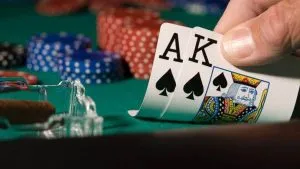Texas Hold’em is widely regarded as the peak achievement in poker because it checks the mathematical and psychological capabilities of players as well as their card skills. In this article, we will bask in principles and strategies for this game to understand how and why has become the most popular variation of poker in the world.
Is Texas Holdem a difficult game?
Texas Holdem Poker Principles are not complicated to get to know them only a few minutes.
However, as the well-known poker claim says “Rules can be assimilated in five minutes but we learn games”.
In the Texas Holdem game, there are shared cards. This is a total of 5 cards lined on the table and visible to all players.
In addition, each player of Posia 2 cards is only visible to him.
Player Knowing his 2 cards covered and seeing a shared card and watching the style of the opponent’s game can with a high probability to assess both the strength of his hand and predict the behavior of another player.
This causes Texas Holdem to be considered a game of skills.
Confirmation is that many players in the world from playing poker made a profession and a constant source of income.

Before the first hand of the card
Let’s assume that all players already have their chips in front of them. The next important issue is the choice of a player who will start as a dealer.
Texas Holdem is played involving the so-called sliding dealer.
This means that each player is on button (In the distribution position, and thus gives away the cards in the last order) with only one hand.
After completing the “Dealer” party, it moves one place to the left.
To choose a person who will start in this position, we distribute all players on one card.
We can also put all the cards on the table and players themselves draw one.
A competitor with the strongest card (AS is the highest card) begins as a distributing so-called “Dealer”.
Dealer not only gives out cards (in the casino and online poker will do it for him) but also as the last decisions in your turn.
This is important because knowing how to learn players in front of you, he has the fullest knowledge in the hand.
Because the “Button” position gives an advantage over opponents, after each hand, Button moves one place to the left.
Even if the player on the button physically does not give away cards (eg when the card gives away the dealer) it is called a dealer.
After completing the party, the player who was on the dealer moves Button to the player after he left.
When we know who is a dealer, dark (blind) must appear on the table. In Poker Texas Holdem there are two dark: A small dark and big dark.
The first player on the left from the dealer pays a small dark. A big dark (double or similar double value) is paid by the player on the left from a small dark.
The height of dark indicates the size of the rates in a given game.
If you want to pay for 200 zlotys, you should sit on the dark table 1AUD / 2PLN, or 1AUD / 2.5PLN.
Once we will determine the size of the blinds, we can proceed to distribute chips.
In the above example, it will be 1AUD nominal chips, 2 AUD or 2.5 AUD, and a few o Nominals 5AUD and AUD 10.
We give out such some chips with specific denominations so that the game goes smoothly.
Each player will need tokens with the smallest denomination only to pay a small dark. The number of such chips should not exceed 10% of the total.
Typically, chips with a larger denomination are used to conquer. If everyone already has their chips and dark lie on the table, we proceed to hand out cards.
Deal
The dealer begins to hand out cards from the first person to the left from Button. Continuing clockwise, it gives each player after one card.
The distributing finishes to give away at the moment when all players have two cards ahead of each other.
These two cards are popularly called “hand” or “hole cards”.
One party in Holdemie consists of a minimum of one and a maximum of four bidding rounds.
The hand ends if all opponents continue or if all four rounds of bidding are completed.
If at least two players are still in the game, the cards are unveiled.
Flop
When all players receive their cards, the Preflop bidding round begins.
Each player should look at his cards so that no one would see them. Then he performs his movement.
In Holdem Poker, only one player can perform in one moment.
The round of flop bet starts from the first player to the left of the big dark. This competitor has three options to choose from:
- Not: You pay nothing, throws your hand, and wait for the next hand.
- Checking: They throw the equivalent of large darkness to the pool.
- I conquer: They throw at a minimum of two times as much as the value of a large dark. It can be more than a double dark size depending on the game limit.
At the moment when the player performs his movement, the action goes to the next player on the left.
Each player has to choose the same options: the belt, check (if the opponent from the right conquered, then you must check this specific value), or conquer.
The conquer must have a minimum of one beating for which the previous rate has been increased.
Flop Turn River
- Flop
A maximum of 5 common cards will be linked in the game. 3 will be exposed on the flop.
The flop is lined at the end of the first round of betting.
We smoke the first card from above (we put it back aside) and we lect 3 more, so that all players can see them (we do not discover the burned card).
At the time of linking, the FLOPA starts another round of bidding.
The rules of poker in this round are the same as in the round of flop with two small exceptions.
The auction begins with the first player to the left of Button who is still in hand.
The player has two options: wait or beat.
If none of the players do bivia, checking for subsequent players is free.
If in this round you want to conjure this minimum amount of beating is the size of a large dark.
- Turn
After completing the previous round of betting, the dealer piles the first card from above and discovers another. It puts it next to cards lined on the flop.
The third round of betting looks the same as the round on the flop.
- River
Assuming that there remained more than one player in the game, we are led to a river card. We make it identical to the turn.
We smoke the first card from above and discover the next placement next to the turn.
This is the last shared card we discovered.
The last round of bidding begins, whose principles are identical to in previous rounds.
Showdown
After the last round of the auction, players who were in the game discovered their cards. The best hand wins the hand.
Showdown rules:
- The player who made the beater must show the cards first.
- If someone else does it earlier it’s OK.
- If he did bivinate none of the players on the River, the first reversal of the player closest to Dealer on the left.
- If one of the opponents has a worse layout than the one already discovered, it can undergo a pot to match the card without unveiling them.

What’s next?
Training, training, and training again.
Good knowledge of the rules is not enough to play poker.
First, based on common cards and opponents’ decisions, you must learn how to best estimate the strength of your layout about the opponent’s cards unknown.
There is still a mastery of such concepts as bluffing, managing your bankroll, or more advanced conquering and fit strategies.
Maybe it sounds complicated, but you will learn everything. Give yourself time.
Practice and a lot read about poker. Well, just enjoy the game and competition – whether in home games with colleagues or online poker versus players from around the world.
In the beginning, take a fundamental ability to determine the strength of their layouts. This is the basis!
Before you try your strength in a real money game, play a minimum of 1000 hands to virtual chips in casinos below.
At every stage of the hand, try to guess:
- What are currently 2 cards that create the most powerful layout?
- What card can have each of your opponents?
- Which players hold the most powerful layout at any time?








